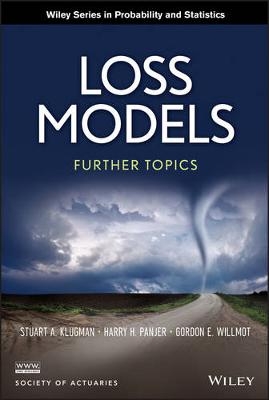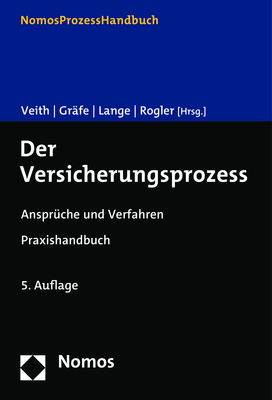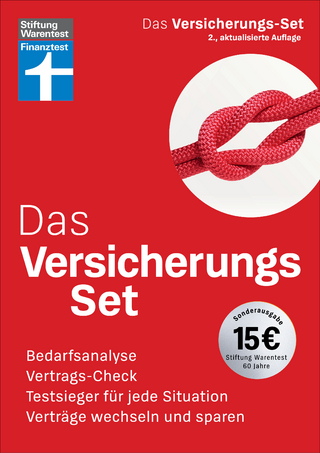
Loss Models
John Wiley & Sons Inc (Verlag)
978-1-118-34356-2 (ISBN)
- Lieferbar (Termin unbekannt)
- Versandkostenfrei innerhalb Deutschlands
- Auch auf Rechnung
- Verfügbarkeit in der Filiale vor Ort prüfen
- Artikel merken
An essential resource for constructing and analyzing advanced actuarial models
Loss Models: Further Topics presents extended coverage of modeling through the use of tools related to risk theory, loss distributions, and survival models. The book uses these methods to construct and evaluate actuarial models in the fields of insurance and business. Providing an advanced study of actuarial methods, the book features extended discussions of risk modeling and risk measures, including Tail-Value-at-Risk. Loss Models: Further Topics contains additional material to accompany the Fourth Edition of Loss Models: From Data to Decisions, such as:
Extreme value distributions
Coxian and related distributions
Mixed Erlang distributions
Computational and analytical methods for aggregate claim models
Counting processes
Compound distributions with time-dependent claim amounts
Copula models
Continuous time ruin models
Interpolation and smoothing
The book is an essential reference for practicing actuaries and actuarial researchers who want to go beyond the material required for actuarial qualification. Loss Models: Further Topics is also an excellent resource for graduate students in the actuarial field.
STUART A. KLUGMAN, PhD, is Staff Fellow (Education) at the Society of Actuaries and Principal Financial Group Distinguished Professor Emeritus of Actuarial Science at Drake University. Dr. Klugman is a two-time recipient of the Society of Actuaries' Presidential Award. HARRY H. PANJER, PhD, is Distinguished Professor Emeritus in the Department of Statistics and Actuarial Science at the University of Waterloo, Canada. Dr. Panjer was previously president of the Canadian Institute of Actuaries and the Society of Actuaries. GORDON E. WILLMOT, PhD, is Munich Re Chair in Insurance and Professor in the Department of Statistics and Actuarial Science at the University of Waterloo, Canada. Dr. Willmot has authored more than eighty-five articles in the areas of risk theory, queuing theory, distribution theory, and stochastic modeling in insurance.
Preface xi
1 Introduction 1
2 Coxian and related distributions 3
2.1 Introduction 3
2.2 Combinations of exponentials 4
2.3 Coxian-2 distributions 7
3 Mixed Erlang distributions 11
3.1 Introduction 11
3.2 Members of the mixed Erlang class 12
3.3 Distributional properties 18
3.4 Mixed Erlang claim severity models 22
4 Extreme value distributions 23
4.1 Introduction 23
4.2 Distribution of the maximum 25
4.2.1 From a fixed number of losses 25
4.2.2 From a random number of losses 27
4.3 Stability of the maximum of the extreme value distribution 29
4.4 The Fisher–Tippett theorem 30
4.5 Maximum domain of attraction 32
4.6 Generalized Pareto distributions 34
4.7 Stability of excesses of the generalized Pareto 36
4.8 Limiting distributions of excesses 37
4.9 Parameter estimation 39
4.9.1 Maximum likelihood estimation from the extreme value distribution 39
4.9.2 Maximum likelihood estimation for the generalized Pareto distribution 42
4.9.3 Estimating the Pareto shape parameter 44
4.9.4 Estimating extreme probabilities 47
4.9.5 Mean excess plots 49
4.9.6 Further reading 49
4.9.7 Exercises 49
5 Analytic and related methods for aggregate claim models 51
5.1 Introduction 51
5.2 Elementary approaches 53
5.3 Discrete analogues 58
5.4 Right-tail asymptotics for aggregate losses 63
5.4.1 Exercises 71
6 Computational methods for aggregate models 73
6.1 Recursive techniques for compound distributions 73
6.2 Inversion methods 75
6.2.1 Fast Fourier transform 75
6.2.2 Direct numerical inversion 78
6.3 Calculations with approximate distributions 80
6.3.1 Arithmetic distributions 80
6.3.2 Empirical distributions 83
6.3.3 Piecewise linear cdf 84
6.3.4 Exercises 85
6.4 Comparison of methods 86
6.5 The individual risk model 87
6.5.1 Definition and notation 87
6.5.2 Direct calculation 88
6.5.3 Recursive calculation 89
7 Counting Processes 97
7.1 Nonhomogeneous birth processes 97
7.1.1 Exercises 112
7.2 Mixed Poisson processes 112
7.2.1 Exercises 116
8 Discrete Claim Count Models 119
8.1 Unification of the (a, b, 1) and mixed Poisson classes 119
8.2 A class of discrete generalized tail-based distributions 127
8.3 Higher order generalized tail-based distributions 134
8.4 Mixed Poisson properties of generalized tail-based distributions 139
8.5 Compound geometric properties of generalized tail-based distributions 146
8.5.1 Exercises 156
9 Compound distributions with time dependent claim amounts 159
9.1 Introduction 159
9.2 A model for inflation 163
9.3 A model for claim payment delays 173
10 Copula models 187
10.1 Introduction 187
10.2 Sklar’s theorem and copulas 188
10.3 Measures of dependency 189
10.3.1 Spearman’s rho 190
10.3.2 Kendall’s tau 190
10.4 Tail dependence 191
10.5 Archimedean copulas 192
10.5.1 Exercise 197
10.6 Elliptical copulas 197
10.6.1 Exercise 199
10.7 Extreme value copulas 200
10.7.1 Exercises 202
10.8 Archimax copulas 203
10.9 Estimation of parameters 203
10.9.1 Introduction 203
10.9.2 Maximum likelihood estimation 204
10.9.3 Semiparametric estimation 206
10.9.4 The role of deductibles 206
10.9.5 Goodness-of-fit testing 208
10.9.6 An example 209
10.9.7 Exercise 210
10.10 Simulation from Copula Models 211
10.10.1 Simulating from the Gaussian copula 213
10.10.2 Simulating from the t copula 213
11 Continuous-time ruin models 215
11.1 Introduction 215
11.1.1 The Poisson process 215
11.1.2 The continuous-time problem 216
11.2 The adjustment coefficient and Lundberg’s inequality 217
11.2.1 The adjustment coefficient 217
11.2.2 Lundberg’s inequality 221
11.2.3 Exercises 223
11.3 An integrodifferential equation 224
11.3.1 Exercises 228
11.4 The maximum aggregate loss 229
11.4.1 Exercises 238
11.5 Cramer’s asymptotic ruin formula and Tijms’ approximation 240
11.5.1 Exercises 243
11.6 The Brownian motion risk process 245
11.7 Brownian motion and the probability of ruin 249
12 Interpolation and smoothing 255
12.1 Introduction 255
12.2 Interpolation with splines 257
12.2.1 Exercises 263
12.3 Extrapolating with splines 264
12.3.1 Exercise 265
12.4 Smoothing with splines 265
12.4.1 Exercise 272
A An inventory of continuous distributions 273
A.1 Introduction 273
A.2 Transformed beta family 277
A.2.1 Four-parameter distribution 277
A.2.2 Three-parameter distributions 277
A.2.3 Two-parameter distributions 279
A.3 transformed gamma family 281
A.3.1 Three-parameter distributions 281
A.3.2 Two-parameter distributions 282
A.3.3 One-parameter distributions 283
A.4 Distributions for large losses 284
A.4.1 Extreme value distributions 284
A.4.2 Generalized Pareto distributions 285
A.5 Other distributions 285
A.6 Distributions with finite support 287
B An inventory of discrete distributions 289
B.1 Introduction 289
B.2 The (a, b, 0) class 290
B.3 The (a, b, 1) class 291
B.3.1 The zero-truncated subclass 291
B.3.2 The zero-modified subclass 293
B.4 The compound class 294
B.4.1 Some compound distributions 294
B.5 A hierarchy of discrete distributions 295
C Discretization of the severity distribution 297
C.1 The method of rounding 297
C.2 Mean preserving 298
C.3 Undiscretization of a discretized distribution 298
D Solutions to Exercises 301
D.1 Chapter 4 301
D.2 Chapter 5 303
D.3 Chapter 6 304
D.4 Chapter 7 305
D.5 Chapter 8 312
D.6 Chapter 10 316
D.7 Chapter 11 319
D.8 Chapter 12 333
References 339
Index 345
| Erscheint lt. Verlag | 27.9.2013 |
|---|---|
| Reihe/Serie | Wiley Series in Probability and Statistics |
| Verlagsort | New York |
| Sprache | englisch |
| Maße | 185 x 260 mm |
| Gewicht | 916 g |
| Themenwelt | Mathematik / Informatik ► Mathematik ► Wahrscheinlichkeit / Kombinatorik |
| Betriebswirtschaft / Management ► Spezielle Betriebswirtschaftslehre ► Versicherungsbetriebslehre | |
| Wirtschaft ► Volkswirtschaftslehre ► Ökonometrie | |
| ISBN-10 | 1-118-34356-5 / 1118343565 |
| ISBN-13 | 978-1-118-34356-2 / 9781118343562 |
| Zustand | Neuware |
| Haben Sie eine Frage zum Produkt? |
aus dem Bereich


